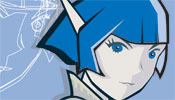
BIOGRAPHY
Partner, Large Animal Games, Inc.
ABSTRACT
Girls Inc. TeamUP: A Case History on Gender, Learning, and Game Design.
Thursday & Friday
This Interactive Exhibit will present a case study of a game designed specifically to strengthen girls' spatial reasoning skills. The public-private partnership between Girls Inc., a nonprofit organization that provides informal after-school education for girls, and Large Animals Games, a commercial game company, developed the game using a combination of standard game conventions and the Girls Inc. educational philosophy and practical experience in creating learning activities for girls. The resulting game, Girls Inc. TeamUP, offers girls the opportunity to build their spatial logic-skills in a fun, challenging environment that encourages exploration, experimentation, and community participation.
We will focus the discussion on the feasibility of building games to promote positive cultural messages, advance specific learning objectives, and encourage participation in a learning community. In particular, we will address how games can address both cultural beliefs about gender and encourage learning through preferred play-patterns. Girls Inc. TeamUP, in keeping with the Girls Inc. mission of inspiring all girls to be strong, smart, and bold, challenges players with fifty levels of increasingly difficult puzzles in which girls are shown as athletic, strong, and daring. And while this is a single-player game, teamwork is central to the play modality-the purpose of the game is to advance from level to level by using the skills of all the girl characters to allow the whole team to advance. Diversity of images is also built into the game, both in the body types of the characters and their ethnicities; players choose the ethnicity of each of the characters.
Girls Inc. TeamUP also provides players with the tools to build their own levels, which are then shared with the player community through a web-server. This feature greatly increases the educational value of the game, since it allows players to build an understanding of spatial relationships and interdependencies in a creative and challenging way. The player-designer has to test each level she designs to determine that it is playable in order for the level to be published to the game server. Feedback is available through a star-rating system used by the player community. The engagement with building the game itself that this feature offers is, we believe, of great value for educators who are interested in using games as part of their curricula. It is also another way in which the game inspires the target audience of girls to recognize and develop confidence in their own agency.
Finally, we will share insights into the business of creating an educational game and the opportunities and challenges of using commercial distribution channels to bring it to the target audience.